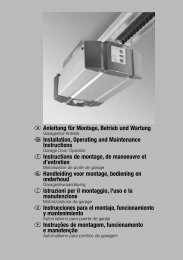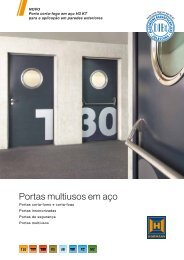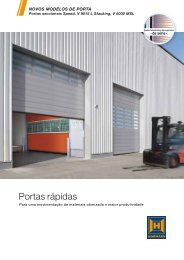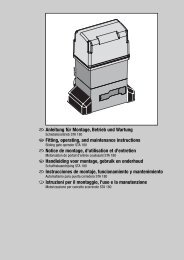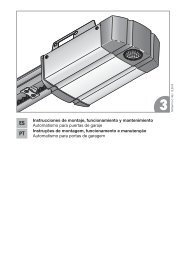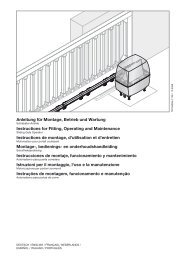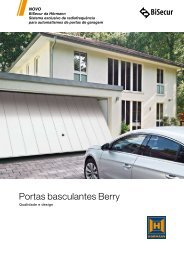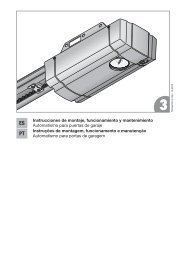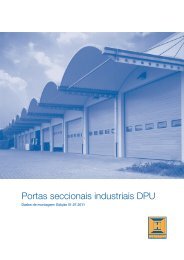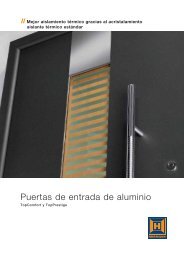Template BA B168xH238 - Hormann.be
Template BA B168xH238 - Hormann.be
Template BA B168xH238 - Hormann.be
Create successful ePaper yourself
Turn your PDF publications into a flip-book with our unique Google optimized e-Paper software.
ENGLISH<br />
2. Set the size of the leaf offset with DIL switch 3:<br />
3 ON Teach in leaf B/small leaf offset<br />
3 OFF Teach in leaf A/large leaf offset<br />
7.1.1 Setting the force limit<br />
Due to special fitting situations, it can, however, happen that<br />
the previously taught-in forces are not high enough which can<br />
then lead to undesired reversing. In such cases, the force limit<br />
can <strong>be</strong> readjusted with a potentiometer, which is located on<br />
the circuit board and la<strong>be</strong>lled with Kraft F.<br />
6<br />
▶ See figure 16<br />
6.1<br />
▶<br />
Gate systems that open outwards<br />
Connecting the operators<br />
See figures 16.2/16.3a/b<br />
Fit the operator cables to the leaf A/leaf B plug as shown in<br />
figure 16.2/16.3.<br />
6.2 Using end stops<br />
We recommend using end stops, as the limit switch cannot<br />
<strong>be</strong> set over the entire spindle stroke. The integrated limit<br />
switch must <strong>be</strong> deactivated for this (see section 5.1.2).<br />
6.3 Using limit switches<br />
▶ See figure 16.1<br />
With gates that open outwards, the limit switch must <strong>be</strong> set in<br />
the direction of the operator motor, as the spindle has to<br />
retract in this case for the gate to move to the CLOSE end-oftravel<br />
position. Using a 3 mm Allen key, move the limit switch<br />
in the indicated direction as shown in figure 16.1.<br />
Note:<br />
Do not use a cordless screwdriver to adjust. One rotation of<br />
the adjusting screw equals 1 mm on the spindle. The limit<br />
switch is not adjustable over the entire spindle stroke!<br />
6.4 Teaching in the end-of-travel positions and<br />
forces<br />
The end-of-travel positions are taught in as descri<strong>be</strong>d in<br />
sections 5.1 / 5.2 and the forces as descri<strong>be</strong>d in section 7.1.<br />
7<br />
Further Work<br />
7.1 Force learning runs<br />
Once the end-of-travel positions have <strong>be</strong>en taught in or after<br />
specific changes, the forces must <strong>be</strong> taught in again. The<br />
gate must <strong>be</strong> closed and two uninterrupted gate cycles must<br />
take place, throughout which none of the safety equipment<br />
may <strong>be</strong> activated. Recording the forces takes place<br />
automatically by press-and-release operation in both<br />
directions, i.e. once an impulse has <strong>be</strong>en given, the operator<br />
causes the gate to travel to the end-of-travel position. The<br />
LED GN flashes throughout. This LED is steadily illuminated<br />
once the force learning cycles have <strong>be</strong>en completed (see<br />
figure 7a.5/7b.9/8a.3/8b.5).<br />
▶ Both of the following procedures must <strong>be</strong> conducted<br />
two times.<br />
Learning the forces to the OPEN end-of-travel position:<br />
▶ Press circuit board button T once.<br />
The operator automatically moves into the OPEN<br />
end‐of‐travel position.<br />
Learning the forces to the CLOSE end-of-travel position:<br />
▶ Press circuit board button T once.<br />
The operator automatically moves into the CLOSE<br />
end‐of-travel position.<br />
WARNING<br />
Force limit too high<br />
If the force limit has <strong>be</strong>en set too high, the gate will not stop<br />
on time when closing and may trap persons or objects.<br />
▶ Do not set a force limit that is too high.<br />
The increase in the force limit is a percentage increase in<br />
relation to the taught-in values; in the process, the setting of<br />
the potentiometer denotes the following force increase<br />
(see figure 10):<br />
Full left<br />
Centred<br />
Full right<br />
To adjust the force limit:<br />
+ 0% force<br />
+15% force<br />
+75% force<br />
1. Adjust the potentiometer Kraft F in the desired direction.<br />
2. The taught-in force setting must <strong>be</strong> checked using a<br />
suitable force measuring device to make sure that the<br />
values are permissible within the application scope of the<br />
European Standards EN 12453 and EN 12445 or the<br />
corresponding national regulations.<br />
3. If the measured force is too high when the potentiometer<br />
setting for the force limit is 0%, it can <strong>be</strong> reduced via a<br />
lower travel speed for normal and slow speed<br />
(see section 7.4.7).<br />
7.2 Connecting safety equipment *<br />
▶ See figures 11.1/11.2<br />
A 2-wire photocell or monitored or unmonitored photocell can<br />
<strong>be</strong> connected to both the SE1 and SE2 safety circuits.<br />
A photocell expander * is required to connect two photocells<br />
to one safety circuit.<br />
Note:<br />
All safety devices should <strong>be</strong> connected step-by-step and<br />
tested.<br />
7.2.1 SE1 safety device in the OPEN direction<br />
SE1 safety device in the OPEN direction. If triggered, brief,<br />
delayed reversing in the CLOSE direction (see figure 11.1)<br />
Electrical connection<br />
Terminal 20<br />
Terminal 18<br />
Terminal 73<br />
Terminal 5<br />
0 V (power supply)<br />
Test signal output<br />
SE1 switch signal input<br />
+24 V (power supply)<br />
* Accessory, not included as standard equipment!<br />
38 TR10A078 RE / 07.2010





